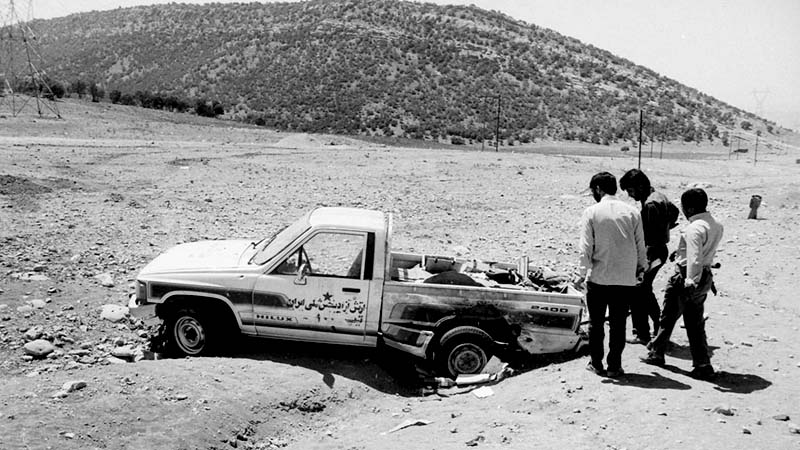The summer of 1988 marked a critical juncture in the tumultuous history of Iran. In the wake of an eight-year war with Iraq, Iran faced a renewed threat on its western borders. The Mujahedin-e Khalq Organization (aka MEK, MKO, PMOI), backed by Saddam Hussein, launched an offensive, codenamed Operation Forough-e Javidan, with the ambitious goal of toppling the Iranian government. However, under immense pressure, Iran countered with Operation Mersad, a swift and decisive response on July 27, 1988 that halted the MEK’s advance. This article examines the events of this pivotal confrontation and explores Saddam’s perspectives to understand the complexities of his relationship with the MEK and how he viewed them as a tool or a liability in his regional ambitions.
According to Iraqi officials, the timing of their 1988 invasion of Iran was a calculated response to a shift in the balance of power. Iran’s recent victories in Operations Valfajr 8 and Karbala 5 had strengthened their hand, prompting Iraq to believe that a revision of the terms of UN Resolution 598, passed at the height of Iran’s success, was necessary. Diplomatic channels proving fruitless, the Iraqi leadership saw a renewed offensive as the only way to regain leverage in negotiations. They launched a two-pronged attack, deploying forces westward and towards the southern cities of Khorramshahr and Ahvaz (1).
However, another analysis suggests Saddam Hussein’s motives were more complex. This view posits that the invasion, undertaken in the war’s waning days, was a gamble – a chance to achieve a decisive victory. Success in this operation would have not only toppled the Iranian government but also installed a loyal government in neighboring Iran, fulfilling a longstanding dream of Saddam. Even defeat, it is argued, held a perverse benefit for Saddam: the elimination of the Mujahedin-e-Khalq (MEK), an Iranian terrorist group the Iraqi dictator viewed as a threat. This perspective suggests that Saddam, motivated by a combination of ambition and paranoia, authorized the invasion despite the war’s near-conclusion and the implementation of Resolution 598 (2). In other words, despite doubts about the operation’s success, Saddam saw the MEK as expendable. In peacetime, they would be a burden – a burned-out and cumbersome pawn. In fact, by greenlighting Operation Eternal Light, Saddam aimed to achieve two objectives: eliminate the MEK, and project goodwill by handing them over to Iran with their own consent. Even if the operation failed, he reasoned, Iran would benefit from the removal of the MEK.
Additionally, some analysts point to Saddam’s own personality as a key factor. They argue that, perceiving Iran as weakened, he sought to deliver a knockout blow or, at the very least, strengthen his bargaining position in ceasefire negotiations. This strategy, they claim, aimed to solidify Iraqi military superiority by capturing Iranian territory and seizing prisoners.
An alternative perspective emerges when examining Saddam’s public statements. On June 29, 1988, he made official pronouncements about peace while condemning Iran’s continued resistance. These pronouncements portrayed him as victorious, bolstered by his perceived support from the United States and its allies. Interestingly, he also included a statement regarding the MEK:
“The Iranian people yearn for peace, and I am confident they will compel their government to pursue it. The heroism of the Mujahedin-e Khalq at Mehran is a testament to this resolve. A day will come when outside intervention is no longer necessary. The MEK will then infiltrate the heart of Iran, and the Iranian people will surely join their cause” (3).
The reality of Operation Eternal Light itself sheds further light on the situation. The plan consisted of three phases: the first two involved large-scale Iraqi offensives, while the third was reserved for the MEK. The Iraqi attacks aimed to breach Iranian defenses in the west and south, while the MEK would then capitalize on the breakthrough for a rapid push towards Tehran.
The prelude to Operation Eternal Light unfolded on July 22, 1988, with a brutal Iraqi offensive. Airstrikes pounded Iranian airbases in the west, followed by aerial and artillery bombardments of Iranian border towns. Simultaneously, a large-scale ground invasion commenced in the south, a clear attempt to distract Iranian forces from the true objective: the MEK’s attack in the west.
The brutality of the offensive extended beyond conventional warfare. Iraqi artillery pounded the strategic Patagh Pass, and chemical weapons were deployed north of the Rijab Pass, inflicting heavy casualties on nearby villages. Propaganda leaflets rained down on Iranian border towns, including Kerend-e Gharb. These leaflets, dropped by Iraqi aircraft, declared a large-scale operation and urged Iranian troops to surrender. In addition, civilians were instructed to evacuate the area (4). This complex operation suggests Saddam may have held some hope for its success, despite doubts about the MEK’s role.
References
1- Source: Journal of Iran-Iraq War Studies, Center for War Studies and Research of the IRGC, No. 17
2- Ali Akbar Rastgoo, The Mujahedin-e Khalq in the Mirror of History, Tehran, Center for Islamic Revolution Documents, 2005, p. 402
3- IRNA Bulletin, June 29, 1988
4- Mujahedin-e Khalq Organization, Arising and the End (1965-2005), Vol. 3, Tehran: Institute of Political Studies and Research, 2006, p. 322


